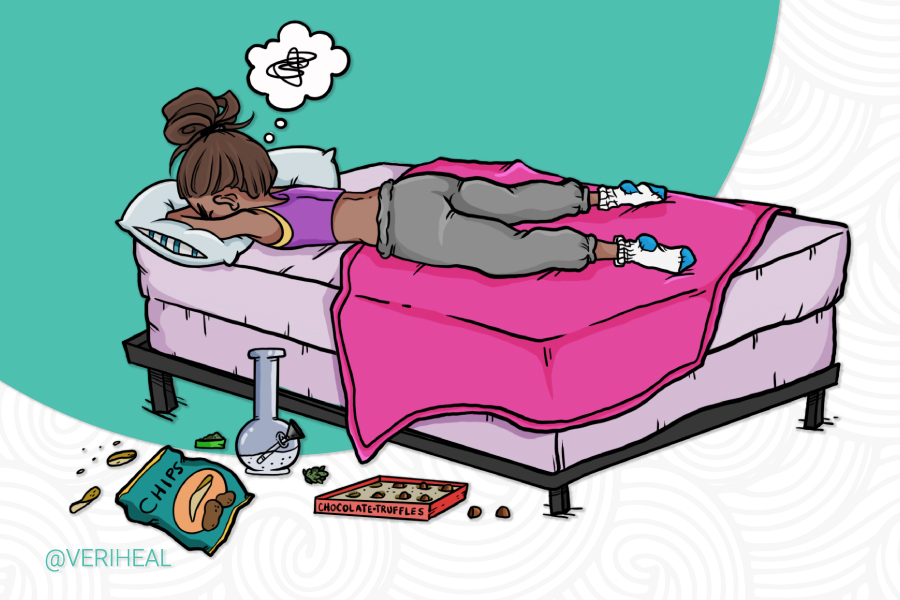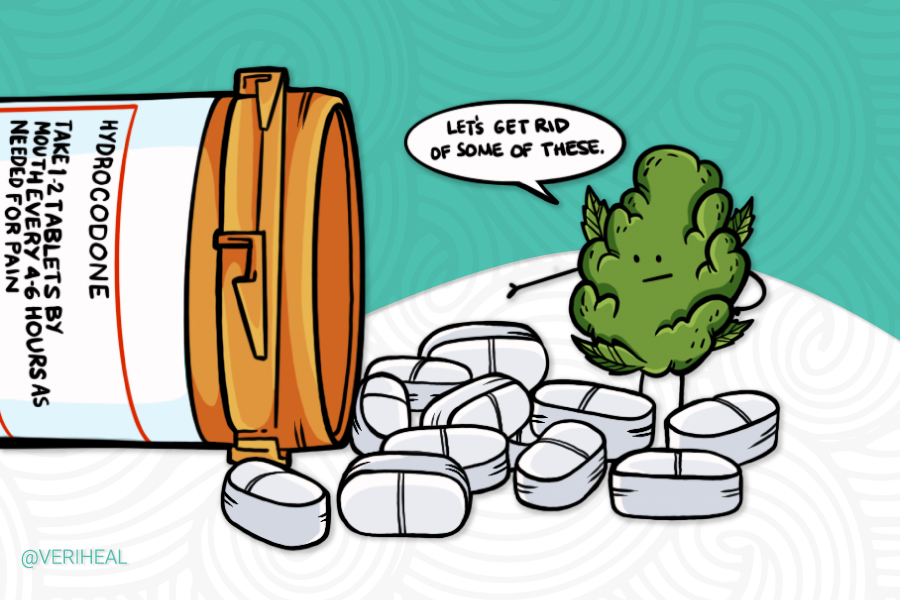Why Women are Turning to Marijuana for Vulvodynia Pain
- Cannabis Delivery Methods for Vaginal Pain
- Different Types of Vulvodynia
- Existing Research on Cannabis and Vulvodynia
- A Women’s Health Professional Weighs In On Cannabis to Treat Vulvodynia
The endocannabinoid system (ECS) affects the central nervous system (CNS), or the brain, as well as the peripheral nervous system, which includes nerve endings in the female reproductive system. Endocannabinoids are fat-soluble neurotransmitters in our bodies that affect pain perception, appetite, and more in our body. It works with both the nervous system and the endocrine system, which regulates reproductive hormones through both cannabinoid receptor CB1 and cannabinoid receptor CB2 (8).
CB1 receptors are mostly located in the brain while CB2 receptors are in the peripheral parts of the immune system. CB2 receptors have been found in the ovaries as well as vaginal tissues (8). The CB2 receptors regulate the functionality of the reproductive system. These receptors also allow the body to feel the effects of cannabidiol (CBD) and Δ9-tetrahydrocannabinol (THC), which is why some women who suffer from vulvodynia and or vaginal or pelvic floor pain choose to use cannabis for pain relief.
Recent preclinical research has suggested that another potential pathway in which THC may reduce labial sensitivity is by the reduction of pro-inflammatory mast cells (a type of white blood cell found in connective tissue) in vaginal tissue. Increases in mast cells are often present in vaginal conditions and are also associated with allergies and other chronic, inflammatory conditions. Conditions like allergies, yeast infections, urogenital infections, depression, and anxiety are associated with an increased risk of this condition (3).
For more information on how the ECS works, please see our page here.
Cannabis Delivery Methods for Vaginal Pain
Because the vaginal canal has a mucosal lining that can quickly absorb medications into the body, methods that deliver THC and CBD directly in the vagina are a common choice for managing vaginal pain and vulvodynia with medical marijuana (5). Medical marijuana products that deliver cannabinoids vaginally include CBD or THC suppositories as well and specially formulated personal lubricants that may potentially help with pelvic pain.
When using cannabis and CBD vaginally, it is important to research the quality and ingredients of the CBD products you use to avoid irritation and to speak to your gynecologist first. A diagnosis like vulvodynia can only be made and treated once other potentially serious conditions have been excluded by a healthcare professional.
Different Types of Vulvodynia
As you may or may not know, vulvodynia is more complicated than just vaginal or pelvic pain. In fact, it is defined by chronic pain at the vaginal opening that has an unidentifiable cause (9). This condition can be hard to treat because the type of pain, severity, and location of the pain vary in each individual. It can also be a difficult diagnosis to make because it is important to distinguish it from other conditions by consulting a healthcare provider first.
Women can experience localized or general forms of this condition, and sometimes both or other subdivision types can co-exist in the same person (9). More details about these subsets are listed below.
- Generalized vulvodynia (GV) is pain that occurs spontaneously and then is relatively constant, but with periods of symptom relief. Activities that apply pressure to the vulva, such as sexual intercourse or sitting too long, can exacerbate the pain (9).
- Localized vulvodynia is categorized by pain that occurs on only one part of the vulva. When the pain is located around the vaginal opening, otherwise known as the vaginal vestibule, it is called vestibulodynia. Most women who have vestibulodynia have provoked vestibulodynia (PVD), or pain that occurs with pressure around the vaginal opening, such as during sexual intercourse, tampon insertion, pelvic exams, prolonged sitting, and wearing tightly fitting pants. Clitorodynia occurs when the vulvar pain is in the clitoris (9).
Women suffering from this condition may choose to seek physical therapy and may be prescribed suppositories as an analgesic (pain reliever).
Existing Research on Cannabis and Vulvodynia
A 2020 research study published in the journal Cannabis used online survey data to help understand the relationship between vulvodynia and symptom relief using cannabis. Symptoms in 38 women with the condition included vulval soreness, burning, stinging, rawness, itching and stabbing pain. The pain examined occurred during sexual intercourse (also known as dyspareunia), prolonged sitting, tampon insertion, wearing tight-fitting pants, and while exercising (1).
The data showed that the higher in severity of reported symptoms, the more likely the women were to state that medicinal marijuana use helped with those symptoms. The biggest symptoms that women reported were pain with sexual intercourse and stabbing vulvar pain (1).
Thus, the study suggests that women who experience a higher severity of painful symptoms are more likely to get relief from cannabis as opposed to experiencing relief from symptoms like itching and tampon insertion pain (1). This small but positive study demonstrates the need for more research on vulvodynia and potential cannabis-based treatment options.
Another study examining the effects of simulated symptoms in mice also shows promising results for human use for vaginal pain. THC and saline were administered into the vaginal canal of mice who were sensitized to vulvar pain. The mice who received the THC and saline mixture experienced a 60% reduction in vaginal pain sensitivity as well as a decrease in local mast cell density (3). Mast cells are responsible for creating inflammation responses in this case. Until large clinical studies are conducted, the effect of medicinal marijuana on quality of life for those with this condition is unclear.
A Women’s Health Professional Weighs In On Cannabis to Treat Vulvodynia
Dr. Becky Lynn is a board-certified gynecologist and highly respected expert in menopause and sexual health. She conducted a 2020 study that investigated how cannabinoids affect female sexual function. Dr. Lynn explains that the activation of CB1 receptors may lead to increased sexual function due to the relationship between CB1 activation on the secretion of serotonin.
In regards to vulvodynia, Dr. Lynn said:
Vulvodynia is frustrating. There is no visible lesion, but patients still feel excruciating pain. Many times they are told it is all in their head. But it isn’t. The pain is real. Cannabis can help treat vulvodynia.
If you’re interested in learning more or have questions about the medical use of cannabis, feel free to contact a cannabis coach or a medical marijuana doctor on Veriheal’s platform.
Note: Veriheal does not intend to give this as professional medical advice. Do not attempt to self-diagnose, or prescribe treatment based on the information provided on this page. Always consult a physician before making any decision on the treatment of a medical condition.
1. Barach, E., Slavin, M., & Earleywine, M. (2020). Cannabis and Vulvodynia Symptoms: A Preliminary Report. Cannabis, 3(2), 139-147. https://pubmed.ncbi.nlm.nih.gov/33426502/.
2. Blake, E. A., Ross, M., Ihenacho, U., Figueroa, L., Silverstein, E., Flink, D., . . . Roman, L. (2019). Non-prescription cannabis use for symptom management amongst women with gynecologic malignancies. Gynecologic Oncology Reports, 30, 100497. https://www.sciencedirect.com/science/article/pii/S2352578919300864.
3. Boo, B., Kamath, R., Arriaga-Gomez, E., Landry, J., Emanuel, E., Joo, S., . . . Chatterjea, D. (2019). Tetrahydrocannabinol Reduces Hapten-Driven Mast Cell Accumulation and Persistent Tactile Sensitivity in Mouse Model of Allergen-Provoked Localized Vulvodynia. International Journal of Molecular Sciences, 20(9), 2163. https://www.ncbi.nlm.nih.gov/pmc/articles/PMC6539044/
4. Brents L. K. (2016). Marijuana, the Endocannabinoid System and the Female Reproductive System. The Yale journal of biology and medicine, 89(2), 175–191. https://pubmed.ncbi.nlm.nih.gov/27354844/
5. Halim, S. (2019, July 08). Cannabis, women’s health, and pelvic conditions. Retrieved November 21, 2020, from https://www.healtheuropa.eu/cannabis-womens-health-pelvic-conditions/92279/
6. Lynn, B., Miller, C., Thompson, J., & Campian, E. (2017). The Relationship Between Marijuana Use Prior to Sex and Sexual Function in Women. The Journal of Sexual Medicine, 14(1). https://www.researchgate.net/publication/331468426_The_Relationship_between_Marijuana_Use_Prior_to_Sex_and_Sexual_Function_in_Women.
7. Russo, E. (2002). Cannabis Treatments in Obstetrics and Gynecology: A Historical Review. Journal of Cannabis Therapeutics, 2(3-4), 5-35. https://www.tandfonline.com/doi/abs/10.1300/J175v02n03_02doi:10.1300/j175v02n03_02.
8. Walker, O. S., Holloway, A. C., & Raha, S. (2019). The role of the endocannabinoid system in female reproductive tissues. Journal of Ovarian Research, 12(1). https://ovarianresearch.biomedcentral.com/articles/10.1186/s13048-018-0478-9.
9. What is Vulvodynia? (2020). Retrieved November 21, 2020, from https://www.nva.org/what-is-vulvodynia/









